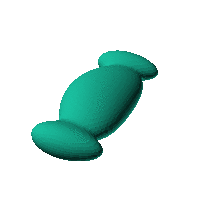The blob in all its glory:
 Twirl with your mouse
Twirl with your mouse
Another take at a spaceship hull. It is made by combining three ellipsoids and doing a bit of spherical inversion to keep things interesting.
|
Click on the snapshot to download the blob's stl file.
|

|
Octave Code:
# name of the blob
project = "blob63";
# function at origin must be <0, and >0 far enough away. w=0 defines the surface
function w = f(x2,y2,z2,c,r) # three lobed toroid with low profile bumps and flat top
x = (x2-c(1))/r(1);
y = (y2-c(2))/r(2);
z = (z2-c(3))/r(3);
w = 0.255721E0.*((-0.526056E4)+0.561298E-13.*y+0.16161E4.*y.^2+ ...
0.305921E-14.*y.^3+(-0.160852E3).*y.^4+0.511052E1.*y.^6+ ...
0.368851E4.*x+(-0.79617E3).*y.^2.*x+(-0.176117E-14).*y.^3.*x+ ...
0.329613E2.*y.^4.*x+0.106268E4.*x.^2+(-0.138229E-12).*y.*x.^2+( ...
-0.170336E3).*y.^2.*x.^2+(-0.76939E-14).*y.^3.*x.^2+0.1458E2.* ...
y.^4.*x.^2+(-0.145112E4).*x.^3+0.867426E-13.*y.*x.^3+0.614442E2.* ...
y.^2.*x.^3+0.192309E-14.*y.^3.*x.^3+0.515008E3.*x.^4+0.31772E1.* ...
y.^2.*x.^4+(-0.836529E2).*x.^5+0.586173E1.*x.^6+0.393914E4.*z.^2+( ...
-0.119903E-13).*y.*z.^2+(-0.71496E3).*y.^2.*z.^2+0.208198E-14.* ...
y.^3.*z.^2+0.462461E2.*y.^4.*z.^2+(-0.327856E4).*x.*z.^2+( ...
-0.126019E-14).*y.*x.*z.^2+0.140416E3.*y.^2.*x.*z.^2+ ...
0.315048E-15.*y.^3.*x.*z.^2+0.163139E4.*x.^2.*z.^2+0.513302E2.* ...
y.^2.*x.^2.*z.^2+(-0.370421E3).*x.^3.*z.^2+0.387234E2.*x.^4.*z.^2+ ...
0.106333E4.*z.^4+0.994194E2.*y.^2.*z.^4+(-0.409955E3).*x.*z.^4+ ...
0.852607E2.*x.^2.*z.^4+0.625681E2.*z.^6);
endfunction;
# this is for distorting the grid before applying the function
# note that the undistorted grid will be used to make the stl file
# just set it to x3=x; y3=y; z3=z; if no warping is needed.
function [x3,y3,z3]= prewarp(x,y,z)
R =425; # center of sphere is at (R+X0,0,0) with radius R (passing through (X0,0,0) )
X0 = 60; # this means that parts of the blob near [X0,0,0] will stay near that point.
# calculate the inverted coordinate of each point in the 3D grid (x3,y3,z3)
x2 = x-R-X0; y2=y; z2 = z; # intermediate values
r2 = R*R./(x2.^2+y2.^2+z2.^2);
x3 = x2.*r2+R+X0; y3 = y2.*r2; z3 = z2.*r2;
endfunction;
c_outer = [0,0,0];
r_outer = [50,50,50];
step = 4; # grid pitch in mm start with 4mm to see the shape quickly. Once you have it just right, change to 2mm for printing
xmin = 0; # avoid the origin because the inverse of the gradient is NaN there
xmax = 250;
ymin = -210;
ymax = 210;
zmin = -100;
zmax = 100;
source("../octave/func2stl_v01.m"); # do all the calculations
GNU Octave




 Twirl with your mouse
Twirl with your mouse

